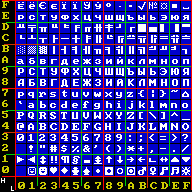Big-5 or Big5 is a Chinese character encoding method used in Taiwan, Hong Kong, and Macau for traditional Chinese characters.
ISO/IEC 8859-11:2001, Information technology — 8-bit single-byte coded graphic character sets — Part 11: Latin/Thai alphabet, is part of the ISO/IEC 8859 series of ASCII-based standard character encodings, first edition published in 2001. It is informally referred to as Latin/Thai. It is nearly identical to the national Thai standard TIS-620 (1990). The sole difference is that ISO/IEC 8859-11 allocates non-breaking space to code 0xA0, while TIS-620 leaves it undefined.
Extended Unix Code (EUC) is a multibyte character encoding system used primarily for Japanese, Korean, and simplified Chinese (characters).
The Hong Kong Supplementary Character Set is a set of Chinese characters – 4,702 in total in the initial release—used in Cantonese, as well as when writing the names of some places in Hong Kong.

Code page 866 is a code page used under DOS and OS/2 in Russia to write Cyrillic script. It is based on the "alternative code page" developed in 1984 in IHNA AS USSR and published in 1986 by a research group at the Academy of Science of the USSR. The code page was widely used during the DOS era because it preserves all of the pseudographic symbols of code page 437 and maintains alphabetic order of Cyrillic letters. Initially this encoding was only available in the Russian version of MS-DOS 4.01 (1990), but with MS-DOS 6.22 it became available in any language version.
Windows code page 1253, commonly known by its IANA-registered name Windows-1253 or abbreviated as cp1253, is a Microsoft Windows code page used to write modern Greek. It is not capable of supporting the older polytonic Greek.
Code page 852 is a code page used under DOS to write Central European languages that use Latin script.
Mac OS Cyrillic is a character encoding used on Apple Macintosh computers to represent texts in the Cyrillic script.
Mac OS Central European is a character encoding used on Apple Macintosh computers to represent texts in Central European and Southeastern European languages that use the Latin script. This encoding is also known as Code Page 10029. IBM assigns code page/CCSID 1282 to this encoding. This codepage contains diacritical letters that ISO 8859-2 does not have, and vice versa.
Code page 865 is a code page used under DOS in Denmark and Norway to write Nordic languages.

Unified Hangul Code (UHC), or Extended Wansung, also known under Microsoft Windows as Code Page 949, is the Microsoft Windows code page for the Korean language. It is an extension of Wansung Code to include all 11172 non-partial Hangul syllables present in Johab. This corresponds to the pre-composed syllables available in Unicode 2.0 and later.

JIS X 0201, a Japanese Industrial Standard developed in 1969, was the first Japanese electronic character set to become widely used. The character set was initially known as JIS C 6220 before the JIS category reform. Its two forms were a 7-bit encoding or an 8-bit encoding, although the 8-bit form was dominant until Unicode replaced it. The full name of this standard is 7-bit and 8-bit coded character sets for information interchange (7ビット及び8ビットの情報交換用符号化文字集合).
Symbol is one of the four standard fonts available on all PostScript-based printers, starting with Apple's original LaserWriter (1985). It contains a complete unaccented Greek alphabet and a selection of commonly used mathematical symbols. Insofar as it fits into any standard classification, it is a serif font designed in the style of Times New Roman.
Mac OS Icelandic is an obsolete character encoding that was used in Apple Macintosh computers to represent Icelandic text. It is largely identical to Mac OS Roman, except for the Icelandic special characters Ý, Þ and Ð which have replaced typography characters.
MacGreek encoding or Macintosh Greek encoding is used in Apple Macintosh computers to represent texts in the Greek language that uses the Greek script. This encoding is registered as IBM code page/CCSID 1280 and Windows code page 10006.
Each character is shown with its equivalent Unicode code point. Only the second half of the table is shown, the first half being the same as ASCII.
Mac OS Croatian is a character encoding used on Apple Macintosh computers to represent Gaj's Latin alphabet. It is a derivative of Mac OS Roman. The three digraphs, Dž, Lj, and Nj, are not encoded.

IBM code page 949 (IBM-949) is a character encoding which has been used by IBM to represent Korean language text on computers. It is a variable-width encoding which represents the characters from the Wansung code defined by the South Korean standard KS X 1001 in a format compatible with EUC-KR, but adds IBM extensions for additional hanja, additional precomposed Hangul syllables, and user-defined characters.
Mac OS Sámi is a character encoding used on classic Mac OS to represent the Sámi languages and the Finnish Kalo language. While not used in any official Apple product, it has been used in various fonts designed to support Sámi languages under classic Mac OS, including those from Evertype. FreeDOS calls it code page 58630.
Code page 1098 (also known as CP 1098, IBM 01098, is a code page used to write Persian in Iran.



